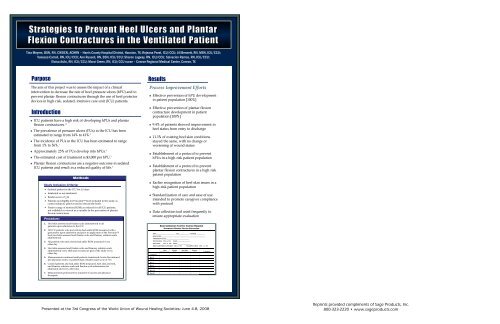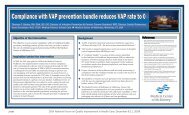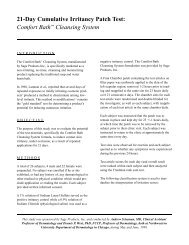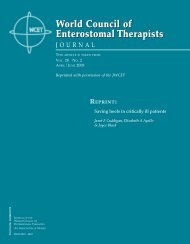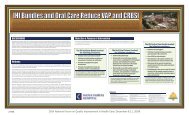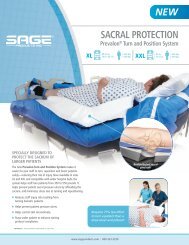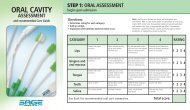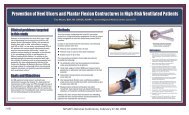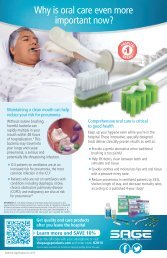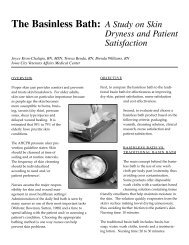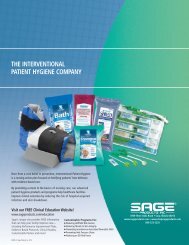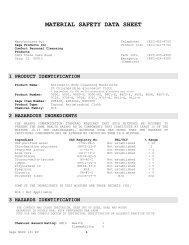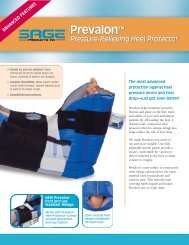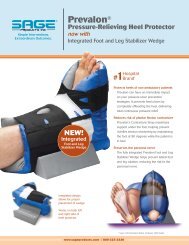100% prevention of plantar flexion contractures - Sage products, Inc.
100% prevention of plantar flexion contractures - Sage products, Inc.
100% prevention of plantar flexion contractures - Sage products, Inc.
You also want an ePaper? Increase the reach of your titles
YUMPU automatically turns print PDFs into web optimized ePapers that Google loves.
Strategies to Prevent Heel Ulcers and Plantar<br />
Flexion Contractures in the Ventilated Patient<br />
Tina Meyers, BSN, RN, CWOCN, ACHRN – Harris County Hospital District, Houston, TX; Rejeana Pezel, ICU/CCU; Jill Bennett, RN, MSN, ICU/CCU;<br />
Vanessa Carroll, RN, ICU/CCU; Ann Russell, RN, BSN, ICU/CCU; Sharon Lagway, RN, ICU/CCU; Salvacion Ramos, RN, ICU/CCU;<br />
Eloisa Asilo, RN, ICU/CCU; Marci Green, RN, ICU/CCU nurse – Conroe Regional Medical Center, Conroe, TX<br />
Purpose<br />
The aim <strong>of</strong> this project was to assess the impact <strong>of</strong> a clinical<br />
intervention to decrease the rate <strong>of</strong> heel pressure ulcers (hPU) and to<br />
prevent <strong>plantar</strong> <strong>flexion</strong> <strong>contractures</strong> through the use <strong>of</strong> heel protector<br />
devices in high-risk, sedated, intensive care unit (ICU) patients.<br />
Introduction<br />
� ICU patients have a high risk <strong>of</strong> developing hPUs and <strong>plantar</strong><br />
<strong>flexion</strong> <strong>contractures</strong>. 1-3<br />
� The prevalence <strong>of</strong> pressure ulcers (PUs) in the ICU has been<br />
estimated to range from 14% to 41%. 1<br />
� The incidence <strong>of</strong> PUs in the ICU has been estimated to range<br />
from 1% to 56%. 1<br />
� Approximately 25% <strong>of</strong> PUs develop into hPUs. 4<br />
� The estimated cost <strong>of</strong> treatment is $3,000 per hPU. 5<br />
� Plantar <strong>flexion</strong> <strong>contractures</strong> are a negative outcome in sedated<br />
ICU patients and result in a reduced quality <strong>of</strong> life. 3<br />
Methods<br />
Study <strong>Inc</strong>lusion Criteria:<br />
� Sedated patient in the ICU for >5 days<br />
� Intubated or not intubated<br />
� Braden score <strong>of</strong> 16<br />
6. Control patients also had ankle ROM measured, heel skin assessed,<br />
and Ramsey sedation scale,and Braden scale administered at<br />
admission and every other day.<br />
7. Measurements performed by trained ICU nurses and physical<br />
therapists<br />
Results<br />
Process Improvement Efforts<br />
� Effective <strong>prevention</strong> <strong>of</strong> hPU development<br />
in patient population [<strong>100%</strong>]<br />
� Effective <strong>prevention</strong> <strong>of</strong> <strong>plantar</strong> <strong>flexion</strong><br />
contracture development in patient<br />
population [<strong>100%</strong>]<br />
� 9.4% <strong>of</strong> patients showed improvement in<br />
heel status from entry to discharge<br />
� 11.3% <strong>of</strong> existing heel skin conditions<br />
stayed the same, with no change or<br />
worsening <strong>of</strong> wound status<br />
� Establishment <strong>of</strong> a protocol to prevent<br />
hPUs in a high-risk patient population<br />
� Establishment <strong>of</strong> a protocol to prevent<br />
<strong>plantar</strong> <strong>flexion</strong> <strong>contractures</strong> in a high-risk<br />
patient population<br />
� Earlier recognition <strong>of</strong> heel skin issues in a<br />
high-risk patient population<br />
� Standardization <strong>of</strong> care and ease <strong>of</strong> use<br />
intended to promote caregiver compliance<br />
with protocol<br />
� Data collection tool used frequently to<br />
ensure appropriate evaluation<br />
Data Collection Tool for Conroe Hospital<br />
Prevalon II Plantar Flexion Prevention<br />
MRN_________________________ AGE_____________ GENDER ____________<br />
DIAGNOSIS____________________________________________________________<br />
ADMISSION DATE________________________________<br />
INTUBATED: YES or NO DATE__________________<br />
SEDATED: YES or NO DATE__________________<br />
PREVALON BOOT APPLIED: YES or NO PILLOWS USED: YES or NO<br />
Admission<br />
Day 3<br />
Day 5<br />
Day 7<br />
Day 9<br />
Day 11<br />
Day 13<br />
Day 15<br />
Ankle<br />
Measurement<br />
Presented at the 3rd Congress <strong>of</strong> the World Union <strong>of</strong> Wound Healing Societies: June 4-8, 2008<br />
Braden<br />
Scale<br />
Heel Skin<br />
Assessment<br />
Ramsey<br />
score<br />
Comments<br />
�<br />
�<br />
Reprints provided compliments <strong>of</strong> <strong>Sage</strong> Products, <strong>Inc</strong>.<br />
800-323-2220 • www.sage<strong>products</strong>.com
el l<br />
Heel<br />
Ulcers<br />
Ulcers<br />
and<br />
and<br />
Plantar<br />
Plantar<br />
Flexion<br />
Flexion<br />
Contractures<br />
Contractures<br />
in in<br />
in<br />
the<br />
the<br />
Ventilated<br />
Ventilated<br />
Patient<br />
Patient<br />
Patient<br />
��<strong>100%</strong> <strong>prevention</strong> <strong>of</strong><br />
�<br />
hospital-acquired hPUs<br />
��<strong>100%</strong> � <strong>prevention</strong> <strong>of</strong> <strong>plantar</strong><br />
<strong>flexion</strong> <strong>contractures</strong><br />
Source: Research Institute for Human Engineering for Quality Life, “Measurement and evaluation <strong>of</strong> the human dynamic characteristics,” Joint<br />
Passive Resistance Database a4, 2000. Available at: http://www.dh.aist.go.jp/bodyDB/a/HQL-00-04e.html<br />
Ramsey Score Averages<br />
Score Entry Totals Exit Totals<br />
1 7 7 8 8<br />
2 22 44 20 40<br />
3 3 9 9 27<br />
4 11 44 11 44<br />
5 7 35 4 20<br />
6 0 0 0 0<br />
Avg. 2.78 2.67<br />
Goniometer used by<br />
trained and licensed<br />
clinicians to assess for<br />
<strong>plantar</strong> <strong>flexion</strong> contracture 6-8<br />
Modified Ramsey Sedation Scale:<br />
1. Anxious, Agitated, Restless<br />
2. Cooperative, Oriented, Tranquil.<br />
Accepts mechanical ventilation.<br />
3. Responds to commands only<br />
4. Brisk response to light glabellar tap or loud noise.<br />
5. Sluggish response to light glabellar tap or loud noise.<br />
6. No Response.<br />
Percentage <strong>of</strong> total heels or patients (%)<br />
Percentage <strong>of</strong> total heels in study (%)<br />
100<br />
90<br />
80<br />
70<br />
60<br />
50<br />
40<br />
30<br />
20<br />
10<br />
0<br />
No. <strong>of</strong> ankles/patients with no <strong>plantar</strong><br />
<strong>flexion</strong> <strong>contractures</strong> (normal)<br />
15<br />
12<br />
9<br />
6<br />
3<br />
0<br />
Assessment <strong>of</strong> hPU Prevention<br />
n = 53 total patients n = 106 total heels<br />
11% <strong>of</strong><br />
patients<br />
stayed<br />
same<br />
9% <strong>of</strong><br />
patients<br />
showed<br />
positive<br />
change<br />
No new<br />
hPUs<br />
developed<br />
8% <strong>of</strong><br />
heels<br />
stayed<br />
same<br />
8% <strong>of</strong><br />
heels<br />
showed<br />
positive<br />
change<br />
Patient Status* Heel Status**<br />
Comparison <strong>of</strong> Entry with Exit Status<br />
Abnormal:Abnormal Abnormal:Normal Normal:Abnormal<br />
* Abnormal patient status means that patient had at least one abnormal heel<br />
** Abnormal heel defined as having status OTHER than pink, clean, clean and dry, OK or intact<br />
Change in Heel/Patient Status<br />
No new<br />
hPUs<br />
developed<br />
Heel Entry Status Heel Exit Status Patient Entry Status Patient Exit Status<br />
120<br />
100<br />
80<br />
60<br />
40<br />
20<br />
n = 106 total heels n = 53 total patients<br />
8%<br />
increase<br />
in<br />
normal<br />
heel<br />
status<br />
50%<br />
decrease in<br />
abnormal<br />
heel status<br />
Comparison <strong>of</strong> Entry with Exit Status<br />
Normal Abnormal*<br />
Assessment <strong>of</strong> Development <strong>of</strong><br />
Plantar Flexion Contractures<br />
n = 53 patients, 106 ankles<br />
<strong>100%</strong><br />
normal<br />
<strong>100%</strong><br />
normal<br />
<strong>100%</strong><br />
normal<br />
<strong>100%</strong><br />
normal<br />
<strong>100%</strong><br />
normal<br />
11%<br />
increase<br />
in<br />
normal<br />
patient<br />
status<br />
* Abnormal patient status means that patient had at least one abnormal heel. Abnormal heel<br />
defined as having status OTHER than pink, clean, clean and dry, OK or intact<br />
<strong>100%</strong><br />
normal<br />
55%<br />
decrease in<br />
abnormal<br />
patient<br />
status<br />
0<br />
On Entry On Exit<br />
No. <strong>of</strong> normal* right ankles No. <strong>of</strong> normal* left ankles No. <strong>of</strong> normal* patients<br />
* Normal = measurements with goniometer within normal range and showing no evidence<br />
<strong>of</strong> <strong>plantar</strong> <strong>flexion</strong> <strong>contractures</strong><br />
Use <strong>of</strong> a heel protector to maintain heel suspension and proper foot and ankle<br />
alignment in 53 sedated ICU patients prevented the development <strong>of</strong> any new<br />
hPUs in this high-risk patient population during this 7-month study.<br />
In addition, an assessment <strong>of</strong> all individual heels (n = 106) indicated that 16 heels<br />
were abnormal upon entry into the study compared with only 8 heels on study<br />
exit, which indicated a 50% decrease in abnormal heel status. Measurement <strong>of</strong><br />
ankle ROM with a goniometer upon admission and every other day for the<br />
duration <strong>of</strong> the study showed no development <strong>of</strong> <strong>plantar</strong> <strong>flexion</strong> <strong>contractures</strong> in<br />
any patient (based on definition <strong>of</strong> contracture -50 [90°=0]).<br />
Conclusion<br />
A comparison <strong>of</strong> the cost <strong>of</strong> heel protector devices with the projected<br />
cost <strong>of</strong> treating hPUs indicated a calculated annual savings <strong>of</strong> $1.9 million.<br />
� A heel protector should be used on all immobile, sedated patients. The results <strong>of</strong> this study<br />
indicate that such use may reduce or eliminate the risk <strong>of</strong> HPUs and help prevent the<br />
development <strong>of</strong> <strong>plantar</strong> <strong>flexion</strong> <strong>contractures</strong>.<br />
� An effective hPU <strong>prevention</strong> protocol that incorporates accurate risk identification, early<br />
recognition <strong>of</strong> skin issues, and methods to maintain heel suspension should be established.<br />
hPUs and <strong>plantar</strong> <strong>flexion</strong> <strong>contractures</strong> may be preventable if standardized protocols<br />
designed to ensure consistent application <strong>of</strong> heel protector devices are followed.<br />
� The proposed hPU <strong>prevention</strong> protocol represents a shift in clinical paradigm from<br />
traditional methods, substantially reduced the risk <strong>of</strong> heel injury, and concomitantly<br />
reduced the risk <strong>of</strong> <strong>plantar</strong> <strong>flexion</strong> contracture in this high-risk patient group.<br />
� The clinical and economic<br />
outcomes <strong>of</strong> this<br />
intervention should be<br />
studied further. The<br />
estimated annual savings<br />
due to <strong>prevention</strong><br />
($1,904,220) are based on the<br />
literature. However,<br />
additional research is<br />
needed to determine the cost<br />
benefit <strong>of</strong> hPU <strong>prevention</strong>.<br />
References<br />
1. Keller BP, Wille J, van Ramshorst B, van der Werken C.<br />
Pressure ulcers in intensive care patients: a review <strong>of</strong> risks<br />
and <strong>prevention</strong>. Intensive Care Med. 2002;28:1379-1388.<br />
2. Jastremski CA. Pressure relief bedding to prevent<br />
pressure ulcer development in critical care. J Crit Care.<br />
2002;17:122-125.<br />
3. Latronico N, Shehu I, Seghelini E. Neuromuscular sequelae<br />
<strong>of</strong> critical illness. Curr Opin Crit Care. 2005;11:381-390.<br />
The heel <strong>prevention</strong><br />
protocol resulted in<br />
annual savings<br />
<strong>of</strong> $1,904,220.<br />
[Avg census 260; 7.3% 4 may develop PUs =<br />
19; 28% 4 may develop HPUs = 5; total hPU<br />
days (365) = 1825; avg LOS 4.6 (NIS Data) =<br />
397 actual hPU days; 93% stage 1 or 2 4 =<br />
369; 7% stage 3 or 4 4 = 28]<br />
Financial Benefits <strong>of</strong> hPU Prevention<br />
$1,400K<br />
$1,200K<br />
$1,000K<br />
$800K<br />
$600K<br />
$400K<br />
$20K<br />
4. Whittington KT, Briones R. National prevalence and<br />
incidence study: 6-year sequential acute care data. Adv<br />
Skin Wound Care. 2004;17:490-494.<br />
5. Courtney B, Ruppman J, Cooper H. Save our skin: initiative<br />
cuts pressure ulcer incidence in half. Nurs Manage. April<br />
2006;37:36-45.<br />
6. Hoppenfeld S. Physical Examination <strong>of</strong> the Spine and<br />
Extremities. Norwalk, CT: Prentice-Hall; 1976.<br />
0<br />
$83,443<br />
$737,935<br />
369<br />
patients 4<br />
$2K<br />
each<br />
aver.<br />
cost 9<br />
$1,249,728<br />
28<br />
patients 4<br />
$45K<br />
each<br />
aver.<br />
cost 9<br />
Cost <strong>of</strong> <strong>prevention</strong> effort Projected Cost <strong>of</strong> Projected Cost <strong>of</strong><br />
(Prevalon purchased) Stage I & II Ulcers Stage III & IV Ulcers<br />
4 Whittington KT, Briones R. Adv Skin Wound Care. 2004;17:490-494; 9 Young ZF, Evans A, Davis J. J Nurs Adm. 2003;33:380-383.<br />
7. Kapandji IA. Ilustrated physiology <strong>of</strong> joints. Med Biol Illus.<br />
1964;14:72-81.<br />
8. Kendall FP, McCreary EK, Provance PG, et al. Muscles:<br />
Testing and Function with Posture and Pain. 5th ed.<br />
Baltimore, MD: Lippincott Williams and Wilkens; 2005.<br />
9. Young ZF, Evans A, Davis J. Nosocomial pressure ulcer<br />
<strong>prevention</strong>: a successful project. J Nurs Adm. 2003;33:<br />
380-383.


